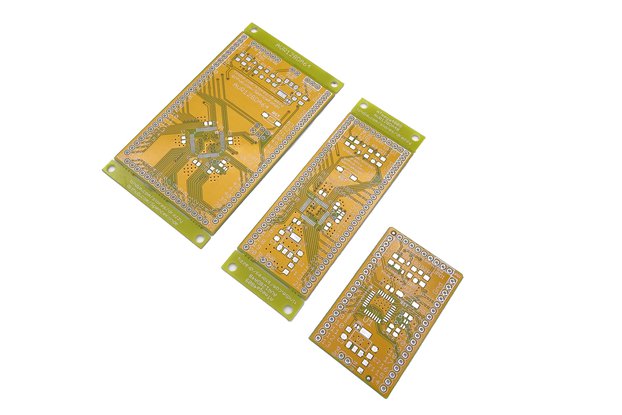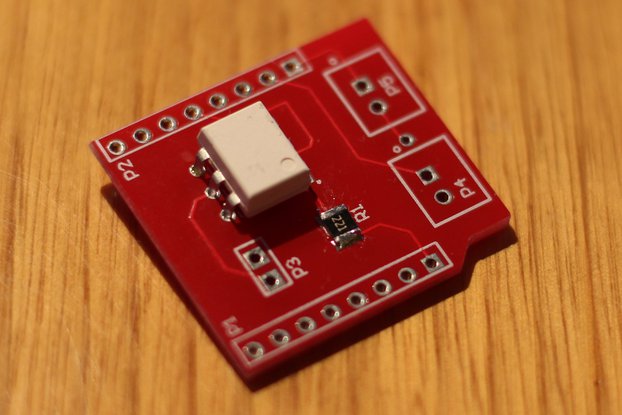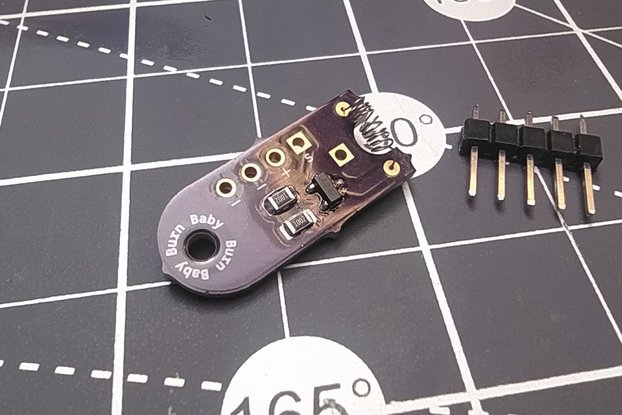Breakout for the VSOP98260 IC and supporting components to transmit and receive modulated IR signals.
Designed by WaffleBomb in United Kingdom
This product is no longer available for sale.
The seller may be offering an improved version or it may be hanging out on the beach, enjoying the retired life.
What is it? This is a breakout for the VSOP98260 from Vishay, which allows you to transmit IR signals and receive MODULATED (like the TSMP58000) IR signals, for the learning of remote codes and modul…
Read More…This is a breakout for the VSOP98260 from Vishay, which allows you to transmit IR signals and receive MODULATED (like the TSMP58000) IR signals, for the learning of remote codes and modulation frequencies. This IC amplifies the signal recieved by an infrared LED - the same one used for transmitting, which saves cost and is pretty cool. The output can be read by a digital input on a microcontroller, though since IR signals transmitted from remotes can be modulated at frequencies as high as 60kHz, you will probably want to use the input capture or interrupt feature on your microcontroller of choice.
Note that, unlike traditional (demodulating) IR recievers, there is no band pass filter and no demodulation, meaning that codes of any frequency from 20kHz to 60kHz can be learned. However, the range is not very far (when using an IR LED as a reciever, it seems to top out at about 15cm in my testing. Vishay reckons about 1m according to this appnote... I'm not sure I believe that) This means it wouldn't be great as a receiver for controlling stuff- stick to code learning.
There are two spots for IR LEDs - one through hole, for LEDs like the (optionally included) TSAL6400, and one for the SMD VSMB2948SL (again optionally included) or other LEDs with similar packages. This means it is possible to create an entirely SMD solution, if you desire. It should be possible to bodge on just about any IR LED- feel free to experiment. Don't use both spots at once!
I wanted to prototype a learning remote- had extra PCBs and wanted to share the love <3
An incredibly useful piece of code that I used with this breakout is Bengt Martensson's AGirs along with his amazing software IRScrutinizer. Together, these programs can turn an arduino into the ultimate universal remote.... when you're connected by USB ':) You can download codes from the web to transmit, or capture codes to be replayed at any time. I've demonstrated it's use in the demo video.
The maximum supply voltage of the VSOP98260 is 3.6V! You should use a VCC of 3.3V (or lower) with this breakout- NOT 5V! That said, use with a 5V logic system is easy- the TX pin goes to a P-Channel MOSFET TSM2323, with a max Vgs of 8V, the RX pin is an output, so as long as you a) have a microcontroller where the logic high voltage is under 3.3V (it usually is) and b) don't accidentally backdrive it that should be fine. For the EN pin you should either ground (logic low) or float (input state) it, so the logic level does not matter.
Speaking of power supply- low noise is important. There is an RC circuit on board as recommended by vishay- but this only filters VCC for the chip, and you can still get noise sneaking in through Q1. I put a 10uF capacitor across the 5V rail in my breadboard to stop noise, since I was using 5V logic on TX. (there should be one there anyway ;) ). Otherwise, you'll get a noisy output and wont be able to see any remote signals unless you go nose to nose with the breakout.
To receive using the IC, ground the EN pin. (the datasheet recommends using an N-Channel MOSFET for this, but most microcontroller pins should be able to sink the IC's required current). Then, your application can receive the amplified (logic level) IR signal on the RX pin. Float (set as input) the EN pin when not in use or when transmitting. I've not seen anything bad happen if you just tie the enable pin for ground for transmitting and recieving- perhaps it could be useful if you want to suppress interrupts from the RX pin?... but then I'd just use an interrupt mask.
The TX pin is connected to a TSM2323 P-Channel MOSFET which controls the LED. That means you can use it to transmit signals, like any IR remote. The current limiting resistor R2 is 10 ohms by default. Using the TSAL6400, the current should be about 170mA, under the LEDs peak forward current rating. If you want to change the resistor, it's 0805 so should be easy to solder (mind the power dissipation rating when picking out a replacement part!) I managed to transmit to my TV from 4.5 meters, but I don't actually have a sightline longer than that, so I guess finding the true maximum range is left as an exercise for the reader ;)

$3.95
Free Shipping!

$4.00
Free Shipping!

$7.80
Free Shipping!

$10.50
Free Shipping!
By clicking Register, you confirm that you accept our Terms & Conditions
We recognize our top users by making them a Tindarian. Tindarians have access to secret & unreleased features.
We look for the most active & best members of the Tindie community, and invite them to join. There isn't a selection process or form to fill out. The only way to become a Tindarian is by being a nice & active member of the Tindie community!
